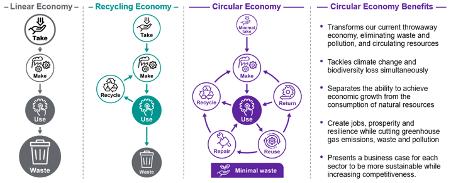This article is brought to you thanks to the collaboration of The European Sting with the World Economic Forum.
Author: Henrik Hvid Jensen, Chief Technology Strategist NEE, DXC Technology
Throughout history, many leading companies have failed to adapt to a changing competitive landscape and adopt new superior business models.
Author Nicolas Carr describes how smart manufacturers at the end of the 19th century saw that one of the great advantages of electric power is that it could be brought directly to workstations. By wiring their plants and installing electric motors they gained an efficiency advantage over their competitors. Similarly, the railroad’s advantage over steamships created mass production sites and crushed small, local plants that until then had dominated manufacturing.
Today, the emergence of digital business models challenges companies who have difficulty moving away from their brick-and-mortar legacy and consequently find themselves with a new digital-born industry leader.
Why a circular economy is the future
The transition to a circular economy is likely to move faster than previous transformations. It has political support, for example, the EU aims to transition to a circular economy to make Europe cleaner and more competitive. Also, unlike previous shifts which often encountered public resistance, there is growing societal pressure for companies to become climate neutral.
Gartner optimistically predicts that by 2029, supply chains will not be allowed to produce waste, as customers and many governments will find it unacceptable. However, it is realistic to expect that during the 2030s the circular economy will not only be the mainstream economy, it will be the only economy.
Much like born-digital companies disrupted traditional business models, we will see born-circular companies disrupting born-linear models. Those needing to adapt must focus on the transition to circularity. It will require abandoning current competitive advantages, writing off important assets, changing well-functioning supply chains, and investing in circular business models. For example, eco-system digitization will be a key advantage in a circular economy. Failure to adapt will result in born-circulars becoming the new industry leaders in the 2030s.
Five key circular business models
The Circular Economy Handbook demonstrates why born-circular companies have a superior business model advantage with these five business models:
1. Circular inputs
In a circular economy, renewable, recycled, or highly recyclable inputs are used in production processes – enabling partial or total elimination of waste and pollution. Waste becomes an asset, not a liability that you pay to dispose of.
Born-circular manufacturers can expect lower costs for their production input as it does not have to be mined from scarce resources – it comes from excess materials and recycled materials.

Born-circular designed products do not become end-of-life instead they become the end-of-current-usage loop. They also benefit from high material and components recovery rates in original quality and increased control of material flow.
For example is it significantly better to recycle used tyres into rubber floor tiles, ink, carpets or car parts, than to export them to India increasing one of the world’s worst pollution crises. But in both cases we see a loss of value, as the high strength steel, kevlar and fibre are gone forever. Instead, the 2030s born-circular’s business model will benefit from the tyre throughout its usage cycle. When a tyre reaches its recycling phase they extract all its original materials and use them to produce new tyres.
2. Sharing economy concept
Born-circulars maximise how idle assets are used across a community while providing customers with affordable and convenient access to products and services. This also includes sharing industrial assets like a conveyor belt, forklift, machinery and warehouses.
Access to an asset no longer requires buying or renting from traditional suppliers but is instead provided by individual people and companies.
Born-circulars, therefore, have a higher utilization percentage of their expensive assets.
3. Product as a service
The customer purchases a service for a limited time while the provider maintains ownership of the product and remains incentivized for the product’s ongoing maintenance, durability, upgrade, and treatment at the end of its use.
The born-circular shifts focus from volume to performance, thus maximizing the usage factor and useful life. They increase resilience by retaining control of products and materials, thereby saving material costs, protecting against material price shocks, and can hedge against material scarcity issues.
The born-circular benefits from continued customer contact and gets insights into how their products are used.
The born-circular gains access to potential untapped opportunities for businesses, for example, a new remanufacturing/refurbishment market.
The provider now has a responsibility and an economic incentive for safer disposal mechanisms, a responsibility previously on the end-user, often without a financial incentive.
For example, SKF’s Oil as a service (RecondOil) changes the use of industrial oils to a circular business model. Traditionally removing contaminant particles smaller than a micron out of industrial oil has been nearly impossible wherefore the quality of lubrication oil is continuously degraded. RecondOil keeps the oil in circulation continuously clean by capturing and separating particles and other impurities down to nano-size.sustainability
What is the World Economic Forum doing about the circular economy?
The World Economic Forum has created a series of initiatives to promote circularity.1. Scale360° Playbook was designed to build lasting ecosystems for the circular economy and help solutions scale.
Its unique hub-based approach – launched this September – is designed to prioritize circular innovation while fostering communities that allow innovators from around the world to share ideas and solutions. Emerging innovators from around the world can connect and work together ideas and solutions through the UpLink, the Forum’s open innovation platform.
Discover how the Scale360° Playbook can drive circular innovation in your community.
Connect to Learn More →
2. A new Circular Cars Initiative (CCI) embodies an ambition for a more circular automotive industry. It represents a coalition of more than 60 automakers, suppliers, research institutions, NGOs and international organizations committed to realizing this near-term ambition.
CCI has recently released a new series of circularity “roadmaps”, developed in collaboration with the World Economic Forum, the World Business Council for Sustainable Development (WBCSD), McKinsey & Co. and Accenture Strategy. These reports explain the specifics of this new circular transition.Connect to Learn More →
3. The World Economic Forum’s Accelerating Digital Traceability for Sustainable Production initiative brings together manufacturers, suppliers, consumers and regulators to jointly establish solutions and provide a supporting ecosystem to increase supply chain visibility and accelerate sustainability and circularity across manufacturing and production sectors.Connect to Learn More →
4. Product use extension
The born-circular designs their products for repairability, upgradability, reusability, ease of disassembly, reconditioning, and recyclability of all components.
In the linear economy, you sell your product to the next in line and the primary interest is in selling as many new products as possible. Whereas, the born-circular designs their business models so they have a continuing income stream throughout the product’s usage cycles.
5. Resource recovery
Resource recovery focuses on the end stages of the usage cycle, namely the recovery of embedded materials, energy, and resources from products at the end of use that is no longer functional in their current application.
The born-circular has a direct economic interest in the extraction of all their products recoverable value. Their design focuses on making value recovery easy and effective. Their business model ensures that users are incentivized to return the products for example contractually, through deposits or in the product-as-a-service model.
The current recycling practice often results in the quality of the materials being degraded. Born-circular ensures resources are recovered so it maintains the highest possible quality. The future material flows are controlled by the born-circular, not by the mining industry.
For example, Vodafone’s trade-in service encourages customers to return their old mobile and tablet devices in exchange for a discount on a new gadget or store credit. The returned items are refurbished and resold or the components stripped and recycled.
Companies must adapt in order to survive
For many companies founded in the linear economy, the shift to a circular economy will be just as difficult as the brick-and-mortar’s transition to a digital business. We will see many legacy companies, unable to adapt in time, lose out to born-circulars who offer: lower costs, recurrent income sources throughout the usage cycles, more climate-friendly and therefore attractive products, higher customer intimacy, and increased resilience due to better control of material flow.
A “do nothing strategy” is not sufficient. Companies must adopt circular elements in their business models, start pilot initiatives, and build a transition strategy with the circular economy concept as a key driver.









